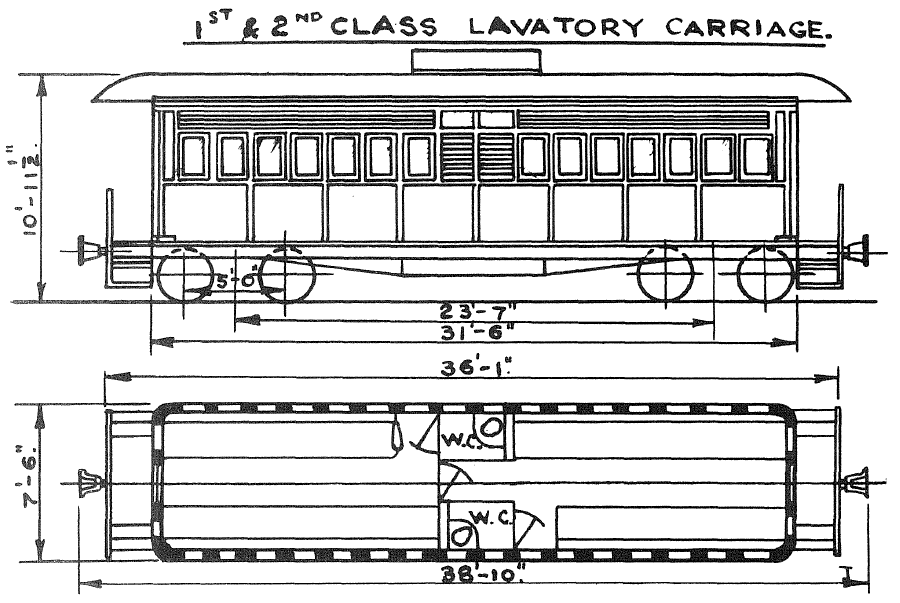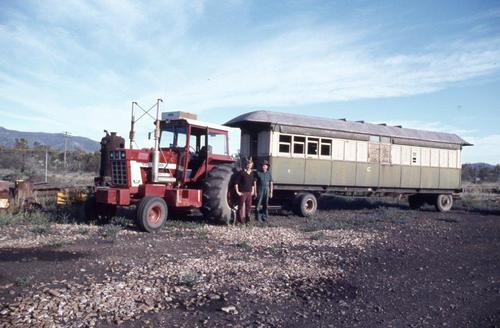
Short tom carriage no. 5 is a first-class carriage and one of a group of six short tom (31' 6") carriages that were built between 1905 and 1907 by the South Australian Railways (SAR) at its Islington Workshops. The other carriages in this group were cars 6, 154, 155, 159 and 160. Car 5 was the only first-class carriage of the group.1
Carriage 5 was issued to the SAR's Northern Division2 and it entered service on 22 April 1905.3 It is the second narrow-gauge SAR carriage to be numbered 5; the original no. 5 was a four-wheeled carriage that was withdrawn from service in 1900.4
Features of this group of short toms are a slightly higher roof line than the previous short toms and that they were fitted with toilets when built.5 As constructed they were configured with longitudinal seats, with a slightly different internal arrangement to the previous short toms. The carriages had two compartments of 13' 5¾" in length (between partitions) and two lavatories located at the centre, one on each side, 3' 7" long and separated by a single longitudinal partition; this arrangement provided no access between the passenger compartments. In each compartment one of the seats was only 11' 5¾" long, which provided space for the outward-opening lavatory door.6
The designated passenger capacities for this group were initially 30 for first-class carriages (car 5), 15 first-class and 17 second-class passengers for composite carriages (cars 154 and 155), and 34 passengers for second-class carriages (cars 6, 159 and 160). These passenger capacities were revised at some later time: the capacity for all of the carriages in this group that were still in service, which were both first- and second-class carriages, was noted as being 26 passengers in 1958. Tare weights varied between 13 ton 10 cwt and 14 ton 10 cwt, and train ratings were 15 or 16 tons.7
These carriages were later modified to enable through access by the creation of a passageway between the two lavatories: the lavatories were made smaller by replacing the original longitudinal partition that separated them with two longitudinal partitions, creating a passageway between them, and a new transverse partition was fitted which had a door to separate the passenger compartments. Electric lighting and Westinghouse air brake equipment were installed on this group of short toms between 1907 and 1925.8
During the Second World War, many of the ageing short tom carriages from all over the SAR were readied for service on the Commonwealth Railways' Central Australia Railway for troop train traffic.9 During the initial stages of the restoration of Car 5 by PRRPS, evidence of its use on WWII troop trains was discovered: soldiers had engraved their names into some interior timber panels. The soldiers that have been identified are: William Henry John Deal (service number VX72569), Sgt Frank Stuart Hutcheson (service no. VX83761), William Fredrick Newell (service number T156069) and Albert Edward Street (service number VX5853).10 Other names found were: Blackmore, Booth, Giblin, Graham, Luttle, Nash and Willoughby.
Car 5's final service was as a railcar trailer; it received cream and green livery for this role.11 It was withdrawn from service on 20 June 1967 and sold to a farm near Terowie.12 The carriage was later acquired by PRRPS, without bogies, and it was delivered to Quorn in November 1977. (Bogies were purchased from Peterborough.)13

1 D B Parsons, The 3ft 6in gauge passenger rolling stock of the South Australian Railways—part 2, ARHS Bulletin no. 250, August 1958, p. 125.
2 J Babbage & R Barrington, The History of Pichi Richi Railway, Pichi Richi Railway Preservation Society Inc, 1984, p 96.
3 C Drymalik, 31 foot 6 inch Short Tom Carriages – "5" Type, http://comrails.com/sar_carriages/c_5_type.html, accessed on 5 January 2016.
4 C Drymalik, 26 foot End Platform Carriages – "3" Type, http://comrails.com/sar_carriages/c_3_type.html#5, accessed on 5 January 2016.
5 J Babbage & R Barrington, The History of Pichi Richi Railway, Pichi Richi Railway Preservation Society Inc, 1984, p 96.
6 D B Parsons, The 3ft 6in gauge passenger rolling stock of the South Australian Railways—part 2, ARHS Bulletin no. 250, August 1958, p. 125.
7 Ibid., pp. 125–126.
8 Ibid.
9 Babbage & Barrington, p. 24.
10 A Wood, Graffiti reveals the past of car 5, Pichi Richi Patter, Vol. 38 No. 1, pp. 6–7.
11 Babbage & Barrington, p 96.
12 C Drymalik, 31 foot 6 inch Short Tom Carriages - "5" Type, http://comrails.com/sar_carriages/c_5_type.html, accessed on 5 January 2016.
13 J Browne, The Travels of Car 5, Pichi Richi Patter, Vol. 39, No. 4, p. 17.
14 Ibid.
